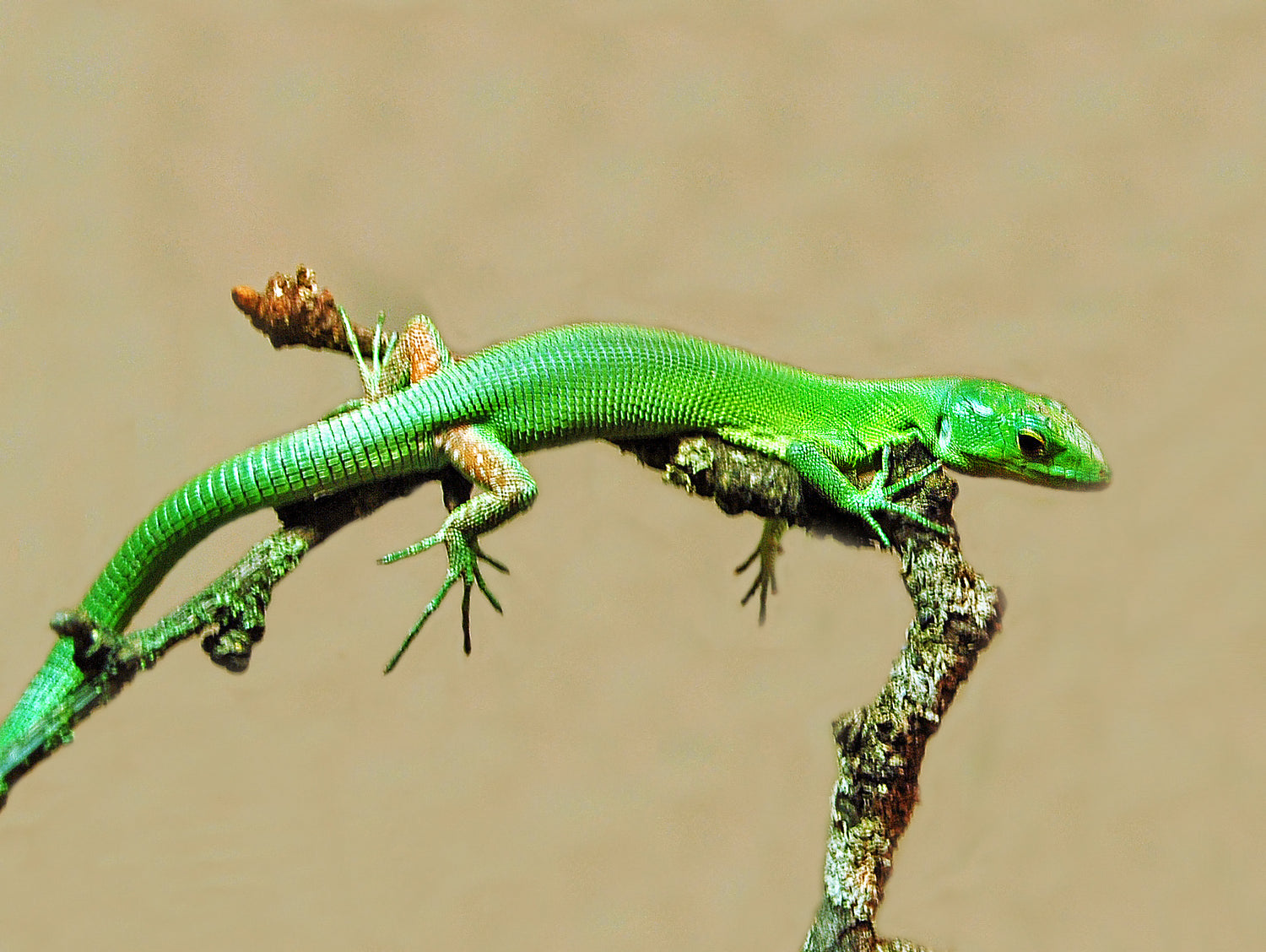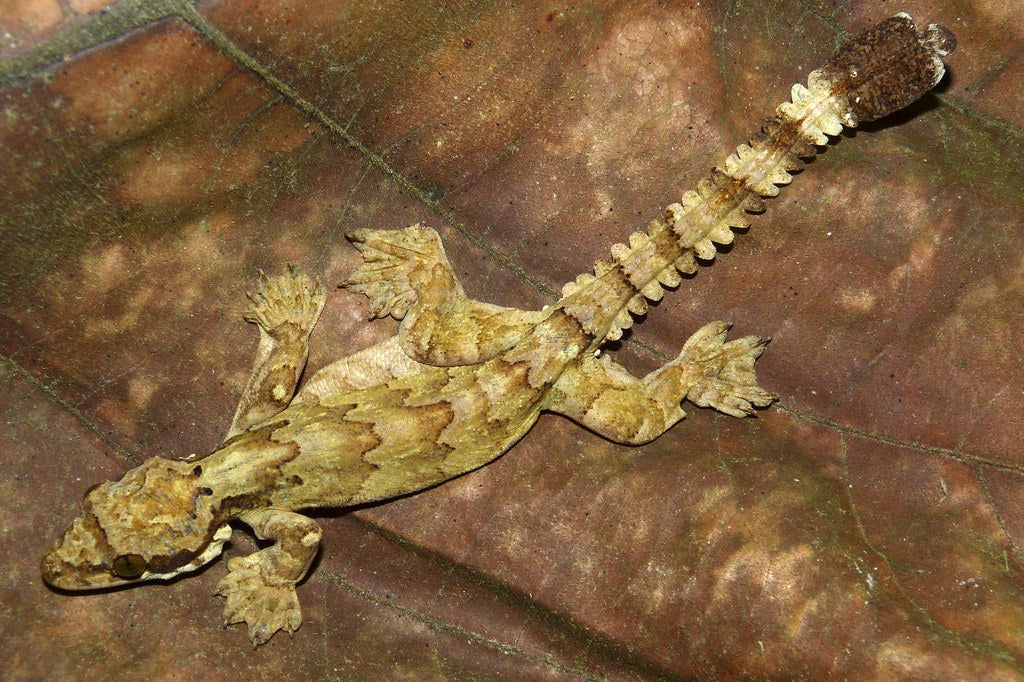Green keel-bellied lizards (Gastropholis prasina) are medium-sized, diurnal, arboreal lizards native to coastal Kenya and Tanzania. Their habitat is exclusive to a couple of types of tree and they spend most of their time in the forest canopy.
Green keel-bellied lizards are typically 10-14” long, with most of their length being tail. They have a slender body with a large, tapered head, large dark eyes, rectangular scales, and long thin toes. They are known for their unique coloration, which is a vibrant turquoise to emerald green.
Although they’re not very handleable, green keel-bellied lizards are well known amongst enthusiasts for their bold and gregarious personalities.
How much space do green keel-bellied lizards need?
Green keel-bellied lizards are active, arboreal lizards who need plenty of space for thermoregulation, climbing, and even leaping. Fortunately, this is fairly easy to provide, given their tiny size. A single green keel-bellied lizard should be housed in absolutely no smaller than a 36” x 18” x 36” terrarium, preferably larger.
Cohabitation (keeping multiple green keel-bellied lizards together) can work if you increase the size of the enclosure proportionately. Do not keep males and females together if you do not plan to breed them, and multiple males housed together may fight.
Do green keel-bellied lizards need UVB?
Yes!
Green keel-bellied lizards require UVB lighting as part of their setup. The best UVB bulbs for green keel-bellied lizards are:
- Arcadia T5 HO 6% — 6-8” above basking branch
- Zoo Med T5 HO Reptisun 5.0 — 6-8” above basking branch
- Arcadia T5 HO 12% — 12-14” above basking branch
- Zoo Med T5 HO Reptisun 10.0 — 12-14” above basking branch
The UVB bulb should be roughly the full length of the enclosure, housed in a reflective fixture, and placed close to the heat lamp. UVB is blocked by glass and plastic, so you can’t give your lizard UVB by placing its terrarium in front of an open window.
Since green keel-bellied lizards have a tendency to climb on the top mesh of their enclosure, it’s safest to prop the UVB lamp up on blocks so it’s 1-2” above the mesh itself. This prevents your lizard from getting exposed to dangerously high levels of UV.
As day-active animals, green keel-bellied lizards also benefit from a 6500K LED or T5 HO fluorescent grow light to provide extra bright light in the enclosure and better simulate the effects of the sun. It’s also essential for nourishing live plants!
Lights should be on for 12 hours/day to provide a natural day/night cycle.
What basking temperatures do green keel-bellied lizards need?
Green keel-bellied lizards should have a basking temperature around 90°F, as measured by a digital probe thermometer with the probe zip-tied to the basking surface. The general temperature in the rest of the enclosure should be maintained between 70-80°F. Nighttime temps should not drop below 65°F.
Provide heat for your lizard by imitating the sun with a cluster of two or more halogen heat bulbs placed on one side of the enclosure. Do not use a CHE or colored bulbs, as these are not as effective.
What humidity levels do green keel-bellied lizards need?
Green keel-bellied lizards need a moderately high humidity environment for best health. Average humidity should be between 60-80%, as measured by a digital probe hygrometer with the probe in the middle of the terrarium. Humidity levels should be higher at night and lower during the day.
Misting your lizard’s enclosure with a sprayer first thing in the morning and again at night will help create the right humidity levels. It also provides an important source of drinking water! If you need help maintaining humidity, using a cool mist humidifier at night (connected to a humidistat) can help.
What substrate is good for green keel-bellied lizards?
Substrate covers the floor of your lizard’s terrarium and helps make the enclosure more attractive, but it also helps maintain humidity. It’s ideal to use a substrate that imitates the “substrate” that the reptile naturally lives on in the wild. For green keel-bellied lizards, that means it should resemble tropical soil. It should have small particles and hold moisture well.
We recommend the following substrates for green keel-bellied lizards:
Layering clean, chemical-free leaf litter on top of the substrate can also help with humidity.
Substrate should be at least 2” deep and completely replaced every 3-4 months. Remove poop and urates daily, along with contaminated substrate.
What decor can you use in a green keel-bellied lizard terrarium?
It’s terribly boring for a green keel-bellied lizard to be stuck in an enclosure with nothing in it except substrate and a branch. It doesn’t matter how big the enclosure is if you don’t put things in it for your pet to use and interact with!
Fill your enclosure with a variety of items to encourage climbing, hiding, and other natural behaviors:
- branches
- vines
- ledges
- textured background
- live or artificial plants
What do green keel-bellied lizards eat?
As lacertids, green keel-bellied lizards are insectivorous, which means that they need to eat a balanced diet of plant and animal matter in order to get the nutrition that their bodies need. Growing juveniles should be fed daily, but adults should be fed only 2-3x/week to help prevent obesity.
Feeder insects for green keel-bellied lizards: dubia roaches, discoid roaches, crickets, hornworms, silkworms, black soldier fly larvae, grasshoppers, mealworms, darkling beetles
Crested gecko diet (CGD) can be offered occasionally as a treat.
Supplements
You will also need calcium and vitamin supplements to prevent your lizard from developing a deficiency. We recommend Repashy Calcium Plus LoD, lightly dusted on all feeder insects. It’s okay to occasionally skip a dusting.
Water
Although your lizard will get most of its drinking water from daily mistings, it’s a good idea to also provide a wall-mounted water dish. Change the water daily and scrub the bowl with a reptile-safe disinfectant weekly, or whenever it becomes soiled.
Do green keel-bellied lizards like to be handled?
Most green keel-bellied lizards have a low tolerance for handling, so it’s best to keep these as a display animal rather than something to pet and hang out with. Instead of interacting with your lizard by holding it, try hand-feeding it instead with a pair of feeding tweezers. They can also be quite fun to watch!
*This care sheet contains only very basic information. Although it’s a good introduction, please do further research with high-quality sources to obtain additional information on caring for this species.
"File:Lacertidae - Gastropholis prasina.JPG" by Hectonichus is licensed under CC BY-SA 4.0




Leave a comment
This site is protected by hCaptcha and the hCaptcha Privacy Policy and Terms of Service apply.